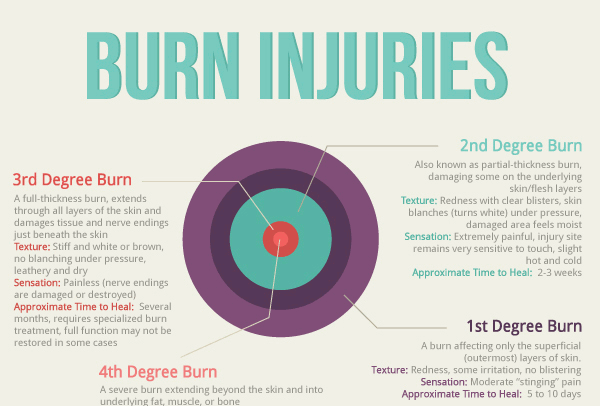

Keep pot handles turned away from the stove front. Do not leave cups, mugs, or bowls containing hot liquids at the edge of a table.A physical therapist teaches you exercises to help improve movement and strength, and to decrease pain. Your muscles and joints may not work well after a second-degree burn. Ask how much liquid to drink each day and which liquids are best for you. You may need to drink extra liquid to help prevent dehydration. Prop your burned arm or leg on pillows or blankets to keep it elevated comfortably. This will help decrease swelling and pain. Elevate your burned arm or leg above the level of your heart as often as you can.

Apply gentle pressure for a few minutes if bleeding occurs.It is too tight if you feel tingling or lose feeling in that area. Wrap a layer of gauze around the bandage to hold it in place.Apply cream or ointment to the burn with a cotton swab.Look for any swelling or redness around the burn. Gently clean the burned area daily with mild soap and water.You may need to soak the bandage in water before you remove it so it will not stick to your wound. Dry your hands with a clean towel or paper towel. View more treatment options How do I care for the burn? Aloe Vera Burn Relief Spray with Lidocaine.The following list of medications are in some way related to or used in the treatment of this condition.
#2nd 3rd 1st degree burn skin#
Surgery can also improve the appearance of your skin and reduce scarring. Surgery can help prevent infection, decrease inflammation, and improve healing. Surgery may remove damaged tissue, replace or cover lost skin, or relieve pressure and improve blood flow.They may be given as a pill or as an ointment applied to your skin. Medicines may be used to decrease pain, prevent infection, or help your burn heal.Laser scanners may be used to check the blood flow in your skin. He or she will examine your burn and determine how severe it is. Your healthcare provider will ask how you were burned. The area may return to red slowly or not all when the pressure is removed. Some areas of redness may turn white when pressure is applied. The skin is mixed red or waxy white, and wet or moist. A deep second-degree burn includes damage in the middle layer, and in the sweat glands and oil glands.The area returns to red quickly when the pressure is removed. Areas of redness turn white when pressure is applied. The skin is red, moist, very painful to the touch, and has blisters.

The deeper layers, sweat glands, and oil glands are not damaged.


 0 kommentar(er)
0 kommentar(er)
